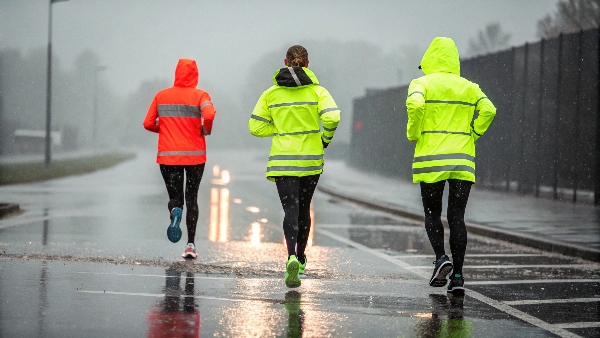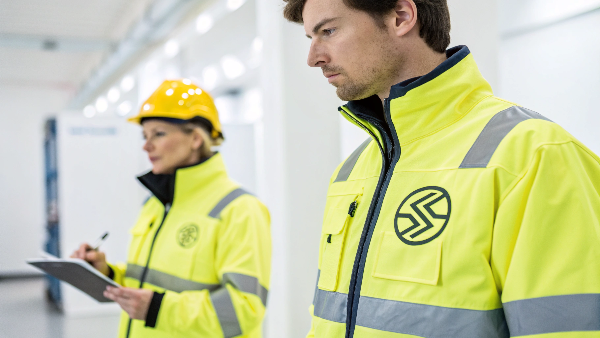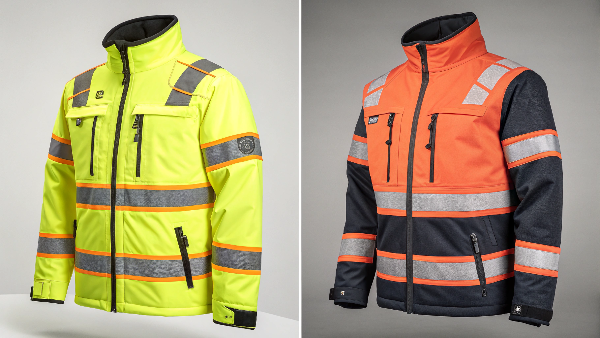As the temperatures rise and the summer sun beats down, many people find themselves struggling to stay cool during outdoor activities, sports, or even everyday tasks. Sweating profusely, feeling overheated, and the risk of heat-related illnesses can turn a pleasant day into an ordeal. You start looking for ways to cool down and discover cooling towels. Do they work, or are they just another overhyped product? In this article, we’ll look at the science behind cooling towels, their effectiveness, and how to use them to stay cool.
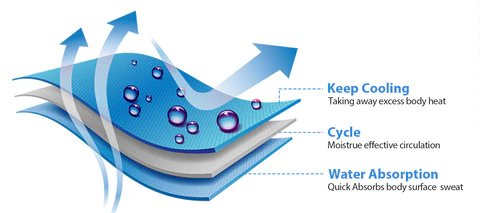
Do Cooling Towels Really Work?
Based on various research and consumer reports, cooling towels do provide some cooling effect, but their effectiveness is not as dramatic as many marketing claims suggest. Here are the key points to consider:
Cooling Effect: Cooling towels do offer some relief and can help lower body temperature, but not to the extent often advertised. The cooling effect is primarily due to evaporative cooling, which is the same principle behind how sweating cools the body.
Lab Tests: In laboratory tests, cooling towels showed some temperature reductions, but results were inconsistent. In some cases, they performed no better than regular towels.
Environmental Factors: The effectiveness of cooling towels depends on environmental factors like humidity and airflow. They work best in low to medium humidity environments and may be less effective in highly humid conditions.
Consumer Reports: Testing by Consumer Reports found that cooling towels performed similarly to a regular cotton dish towel when it comes to lowering surface temperature.
Advantages Over Regular Towels: Cooling towels may have some advantages over regular towels, such as being able to be wrung out more effectively, preventing excessive wetness on clothing, staying cool longer, and providing a barrier between the neck and clothing during exertion.
Use Cases: While not revolutionary, cooling towels can still be useful for various activities and professions involving hot environments, such as construction, landscaping, and sports.
In conclusion, cooling towels do work to some extent, but their effectiveness is often overstated in marketing claims. They can provide some relief from heat, but they are not significantly more effective than using a regular damp towel in many cases.
How Effective is a Cooling Towel?
Consumer Reports Findings
Consumer Reports tested several cooling towels and found that they did not perform significantly better than a regular cotton towel. The cooling effect was similar across different types of towels, including those marketed as having special cooling properties.
Benefits and Use Cases
Cooling towels can provide relief from heat and are useful in various situations such as outdoor activities, sports, and for individuals with heat-related conditions. They work by evaporative cooling, which helps lower skin temperature when the towel is wet and exposed to air. They can also help reduce inflammation and muscle pain, promote faster recovery, and protect the skin from sun damage.
Material and Design
Cooling towels are made from materials like polyvinyl alcohol (PVA), polyester microfiber, and polyester/spandex blends. These materials enhance the evaporative cooling effect and can stay cool for extended periods. PVA towels, in particular, are noted for their high absorbency and ability to stay cool for up to four hours on a single soak.
Practical Considerations
The effectiveness of cooling towels can be influenced by environmental factors such as humidity and airflow. They work best in low to medium humidity environments and may be less effective in highly humid conditions. Proper care and usage, such as soaking the towel thoroughly and wringing out excess water, are essential for maximizing their cooling effect.
Consumer Reviews
Some cooling towels, like the Frogg Toggs Chilly Pad, have received positive reviews for their cooling performance and durability. These towels are praised for their ability to stay damp and cool for several hours, making them suitable for various activities.
In summary, while cooling towels do provide some cooling effect and can be beneficial in certain situations, their performance may not be as exceptional as some marketing claims suggest. They are generally more effective than regular towels due to their specialized materials and design, but their effectiveness can vary based on environmental conditions and proper usage.
How Many Hours Do Cooling Towels Last?
The duration for which cooling towels remain effective varies depending on the brand and environmental conditions. Here are some specific examples:
COLD FACTOR Cooling Neck Towel
Cooling Duration: Stays cool for up to 5 hours once activated, though the total cooling duration can depend on various factors.
U-pick Cooling Towels
Cooling Duration: Typically stay cool for up to 3 hours after wetting, depending on conditions. They need to be soaked for at least 1 minute to achieve the cooling effect and may need re-soaking after about 2 hours.
Arctic Cool Instant Cooling Towel
Cooling Duration: Provides a cooling effect for up to 2 hours. The towel uses HydroFreeze™ Technology to activate the cooling effect instantly when soaked with water.
Frogg Toggs Chilly Pad Cooling Towel
Cooling Duration: Offers hours of cooling relief. The exact duration isn't specified, but it can be re-wet to reactivate the cooling effect when it stops.
Chill-Its 6602 Evaporative Cooling Towel
Cooling Duration: Provides up to 4 hours of cooling relief when activated with water. The towel remains soft and comfortable when wet and can be reactivated by re-wetting.
In summary, cooling towels generally last between 2 to 5 hours, with the exact duration depending on the specific product and environmental conditions. They can be reactivated by soaking them in water again.
Why Does Snapping a Cooling Towel Work?
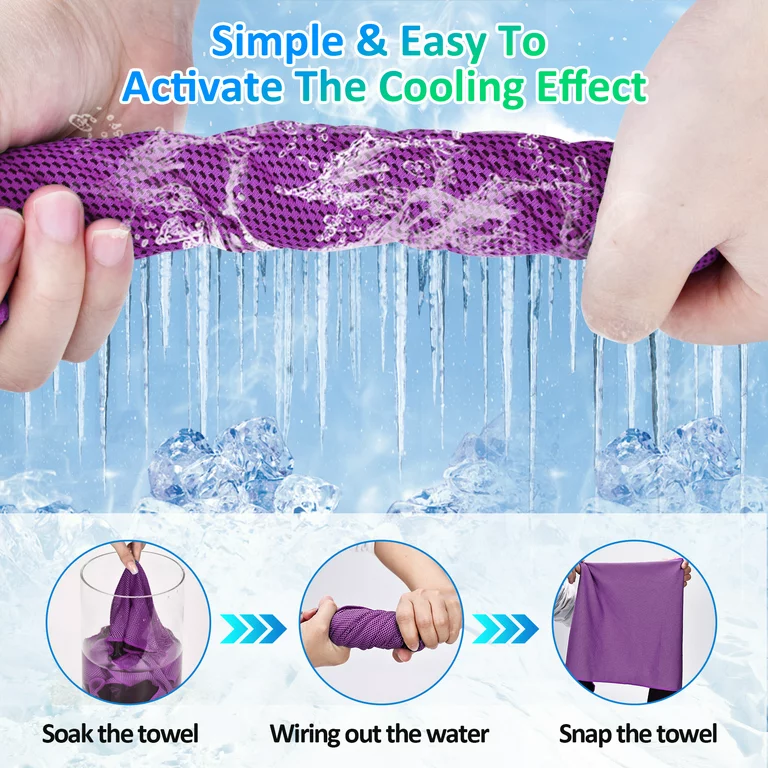
Snapping a cooling towel works through the principle of evaporative cooling. Here's why it's effective:
Evaporation Process
When you snap a wet cooling towel, you rapidly move it through the air. This accelerates the evaporation of water from the towel's surface.
Heat Absorption
As the water evaporates, it absorbs heat energy from its surroundings, including the towel itself and the air around it. This process of evaporation requires energy, which is taken in the form of heat.
Cooling Effect
The absorption of heat during evaporation leaves the towel cooler to the touch. The rapid air movement caused by snapping enhances this effect by increasing the rate of evaporation.
Fabric Design
Many cooling towels are made with specialized materials like polyvinyl alcohol (PVA) or microfiber blends that enhance the evaporative cooling effect. These materials can hold more water and allow for more efficient evaporation.
Activation of Cooling Properties
For some cooling towels, the snapping action helps to activate or distribute the moisture evenly throughout the fabric, ensuring a more uniform cooling effect.
Temporary Effect
The cooling effect is temporary and lasts as long as there is moisture available for evaporation. Once the towel dries out, it needs to be re-wet to continue providing a cooling effect.
It's worth noting that while specialized cooling towels may have some advantages in terms of material and design, Consumer Reports testing found that they don't perform significantly better than regular cotton towels when it comes to the basic cooling effect achieved through evaporation.
Where Do You Put Cold Towels to Cool Down?
Snapping a cooling towel works primarily through the principle of evaporative cooling, which is enhanced by the physical action of snapping. Here’s a detailed explanation:
Evaporative Cooling
When a cooling towel is wet, the water in the towel begins to evaporate. Evaporation is an endothermic process, meaning it absorbs heat from the surroundings, including the towel and the skin it is in contact with. This absorption of heat results in a cooling effect.
Increased Airflow
Snapping the towel increases the airflow around it, which accelerates the evaporation process. The faster the water evaporates, the more heat is absorbed, and the cooler the towel becomes.
Material Properties
Cooling towels are often made from materials like polyvinyl alcohol (PVA) or microfiber, which are designed to retain water and enhance the evaporative cooling effect. These materials can hold more water and release it slowly, prolonging the cooling effect.
Activation of Cooling Properties
The snapping action helps to evenly distribute the water throughout the towel and can also help to activate the cooling properties of the material. This ensures that the towel provides a consistent cooling effect across its surface.
Practical Use
To use a cooling towel effectively, you typically need to soak it in water, wring out the excess, and then snap it to activate the cooling process. This method is simple and can be repeated as needed to maintain the cooling effect.
In summary, snapping a cooling towel enhances its cooling effect by increasing the rate of evaporation, which in turn absorbs more heat and cools the towel more effectively. This process is supported by the specialized materials used in cooling towels, which are designed to retain water and facilitate efficient evaporation.
What is the Best Way to Use a Cooling Towel?
Based on the search results, here are the best ways to use a cooling towel effectively:
Activation Process
1.Wet the Towel Thoroughly: Soak it in cold water for 1-2 minutes.
2.Wring Out Excess Water: Ensure the towel is damp but not dripping.
3.Snap or Shake: Activate the evaporative cooling effect by snapping or shaking the towel in the air.
Application
Placement: Place the activated cooling towel around your neck, on your head, or other pulse points on your body where you want to cool down.
Pulse Points: For maximum effectiveness, apply it to areas with large blood vessels close to the skin surface, like the neck, wrists, or forehead.
Maintaining the Cooling Effect
Keep the Towel Damp: Once it dries out, it will stop working.
Re-wet as Needed: Re-wet the towel to maintain its cooling properties.
Recharge the Cooling Power: Simply re-wet the towel and snap it in the air again.
Duration
Cooling Duration: Depending on the brand and environmental conditions, cooling towels can stay effective for 2-5 hours before needing to be re-wet.
Additional Tips
Enhanced Cooling: Store the damp towel in a plastic bag in the refrigerator for a few hours before use.
Usage: Use the towel during physical activities, in hot environments, or whenever you need to cool down quickly.
Special Uses: Some cooling towels can be used to help with headaches, migraines, or even hangovers.
Remember, the effectiveness of cooling towels relies on the evaporation process, so they work best in environments with low to medium humidity and good airflow.
Should You Wash Cooling Towels?
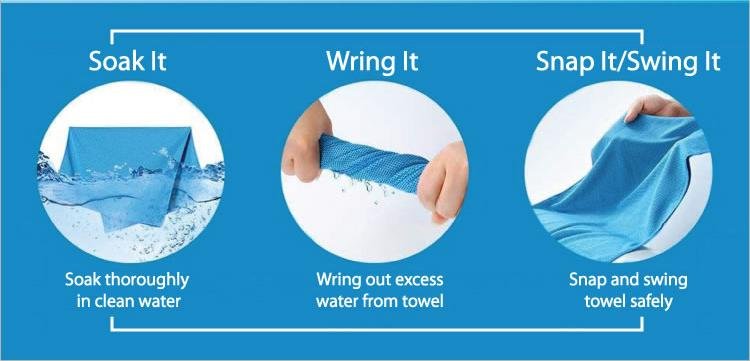
Based on the search results, here are the key points about washing cooling towels:
Washing Frequency
Regular Washing: Cooling towels should be washed regularly to maintain their effectiveness and hygiene.
After Several Uses: It's a good practice to wash them after several uses.
Washing Methods
Hand Washing: You can hand-wash the towel by soaking it in water and wringing it out.
Machine Washing: Many cooling towels can be machine washed using cold water on a gentle cycle.
Water Temperature
Hot or Warm Water: Use hot or warm water for washing, as this helps soften the material and maintain its effectiveness.
Cold Water: For machine washing, cold water is recommended.
Detergent
Mild Detergent: Use a mild detergent when washing cooling towels.
Drying
Air Dry: After washing, hang the towel to air dry.
Sunlight Exposure: Some sources recommend exposing it to sunlight and turning it periodically to allow proper drying.
Maintenance Tips
Rewetting After Washing: Rewetting the towel after washing can help maintain its cooling properties.
Soaking in Warm Water: Soaking in warm water before use can help soften the material and prepare it for use.
Long-Term Care
Proper Cleaning and Maintenance: Proper cleaning and maintenance can help your cooling towel last for several years.
Preventing Ineffectiveness: Regular washing prevents the towel from becoming less effective over time.
Remember, specific care instructions may vary depending on the brand and material of your cooling towel, so it's always best to check the manufacturer's guidelines for optimal care and maintenance.
How Long Do You Soak Cooling Towels?
Based on the search results, here are the key points about soaking cooling towels:
Soak Time
1-2 Minutes: Most sources recommend soaking cooling towels for 1-2 minutes.
Minimum Soak Time: The U-pick Cooling Towels suggest soaking for at least 1 minute to get it cool enough.
Water Temperature
Cold Water: Use cold water for soaking.
Optimal Temperature: Ideally, the water temperature should be between 59 and 68 degrees Fahrenheit for optimal cooling effect.
Activation Process
Wring Out Excess Water: After soaking, wring out the excess water so the towel is damp but not dripping.
Snap or Shake: Some brands recommend snapping or shaking the towel after wringing to activate the cooling effect.
Reactivation
Re-soak as Needed: Once the cooling effect diminishes (typically after 2-3 hours), you can re-soak the towel to reactivate it.
Tips
Ensure Full Submersion: Ensure the entire towel is submerged during soaking.
Enhanced Cooling: For enhanced cooling, some suggest storing the damp towel in a plastic bag in the refrigerator for a few hours before use.
Remember, while these are general guidelines, it's always best to check the specific instructions for your particular cooling towel brand, as there may be slight variations in recommended soaking times and methods.
What is the Best Keep Cool Towel?
Frogg Toggs Chilly Pad
Material: Evaporative polyvinyl alcohol (PVA) fabric.
Cooling Duration: Stays damp and cool for up to 4 hours.
Features: Machine-washable, absorbs up to eight times its weight in water, lightweight.
Reviews: Highly rated with a 4.5-star rating and over 12,500 reviews on Amazon.
Arctic Cool Instant Cooling Towel
Material: High-performance mesh with HydroFreeze™ Technology.
Cooling Duration: Keeps cool for up to 2 hours.
Features: Instant cooling effect, anti-microbial, UPF 50+ protection, machine-washable, durable.
Reviews: Praised for its long-lasting cooling effect and lightweight design.
U-pick Cooling Towels
Material: Microfiber.
Cooling Duration: Stays cool for up to 3 hours.
Features: Chemical-free, UV protection, comes with a waterproof pouch and carabiner, versatile for various activities.
Reviews: Positive feedback for durability and effectiveness, with a 4.7-star rating.
Sukeen Cooling Towels
Material: Microfiber.
Cooling Duration: Stays chilled for up to 3 hours.
Features: Soft, breathable, chemical-free, suitable for neck, face, head, and arms.
Reviews: Customers appreciate the softness and lightweight nature of the towels.
Mission Cooling Hoodie
Material: Breathable mesh fabric.
Cooling Duration: Keeps cool for up to 2 hours.
Features: UPF 50 protection, designed to stay draped without slipping, ideal for physical activities.
Reviews: Over 3,900 5-star ratings on Amazon, praised for its comfort and effectiveness.
Each of these cooling towels has unique features and benefits, making them suitable for different needs and preferences. The Frogg Toggs Chilly Pad and Arctic Cool Instant Cooling Towel are particularly noted for their long-lasting cooling effects and high customer ratings.
Conclusion
In conclusion, cooling towels do work to help you stay cool, but they may not be as life-changing as some people would have you believe. They work through evaporative cooling, which can help you cool down. The effectiveness of cooling towels depends on the environmental conditions, the material, and how you use it. While they may not be that much better than a regular damp towel, they do have some advantages. They stay cool longer, are better at wringing out excess water, and provide a barrier between your neck and your clothing when you’re working hard.
If you work in a hot environment, play sports, or just want to stay cool, a cooling towel can be a helpful tool. By understanding how to use them effectively and considering factors such as soak time, reactivation, and proper care, you can get the most out of your cooling towel and stay cool during the hottest days.

